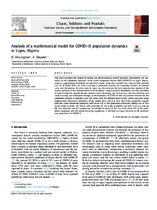Mostrar el registro sencillo del documento
Analysis of a mathematical model for COVID-19 population dynamics in Lagos, Nigeria
| dc.creator | Okuonghae, D. | |
| dc.creator | Omame, A. | |
| dc.date.accessioned | 2020-07-27T20:13:53Z | |
| dc.date.available | 2020-07-27T20:13:53Z | |
| dc.date.created | 2020-10 | |
| dc.identifier.issn | 0960-0779 | spa |
| dc.identifier.other | https://www.sciencedirect.com/science/article/pii/S0960077920304306?via%3Dihub | spa |
| dc.identifier.uri | http://hdl.handle.net/20.500.12010/11221 | |
| dc.format.extent | 18 páginas | spa |
| dc.format.mimetype | application/pdf | spa |
| dc.publisher | Chaos, Solitons and Fractals | eng |
| dc.source | reponame:Expeditio Repositorio Institucional UJTL | spa |
| dc.source | instname:Universidad de Bogotá Jorge Tadeo Lozano | spa |
| dc.subject | Distanciamiento social | spa |
| dc.title | Analysis of a mathematical model for COVID-19 population dynamics in Lagos, Nigeria | spa |
| dc.type.local | Artículo | spa |
| dc.subject.lemb | Síndrome respiratorio agudo grave | spa |
| dc.subject.lemb | COVID-19 | spa |
| dc.subject.lemb | SARS-CoV-2 | spa |
| dc.subject.lemb | Coronavirus | spa |
| dc.rights.accessrights | info:eu-repo/semantics/openAccess | spa |
| dc.type.hasversion | info:eu-repo/semantics/acceptedVersion | spa |
| dc.subject.keyword | Social distancing | spa |
| dc.subject.keyword | Face-Mask | spa |
| dc.subject.keyword | Case-Detection | spa |
| dc.subject.keyword | Model-FittingSimulations | spa |
| dc.identifier.doi | https://doi.org/10.1016/j.chaos.2020.110032 | spa |
| dc.description.abstractenglish | This work examines the impact of various non-pharmaceutical control measures (government and personal) on the population dynamics of the novel coronavirus disease 2019 (COVID-19) in Lagos, Nigeria, using an appropriately formulated mathematical model. Using the available data, since its first reported case on 16 March 2020, we seek to develop a predicative tool for the cumulative number of reported cases and the number of active cases in Lagos; we also estimate the basic reproduction number of the disease outbreak in the aforementioned State in Nigeria. Using numerical simulations, we show the effect of control measures, specifically the common social distancing, use of face mask and case detection (via contact tracing and subsequent testings) on the dynamics of COVID-19. We also provide forecasts for the cumulative number of reported cases and active cases for different levels of the control measures being implemented. Numerical simulations of the model show that if at least 55% of the population comply with the social distancing regulation with about 55% of the population effectively making use of face masks while in public, the disease will eventually die out in the population and that, if we can step up the case detection rate for symptomatic individuals to about 0.8 per day, with about 55% of the population complying with the social distancing regulations, it will lead to a great decrease in the incidence (and prevalence) of COVID-19. | spa |

